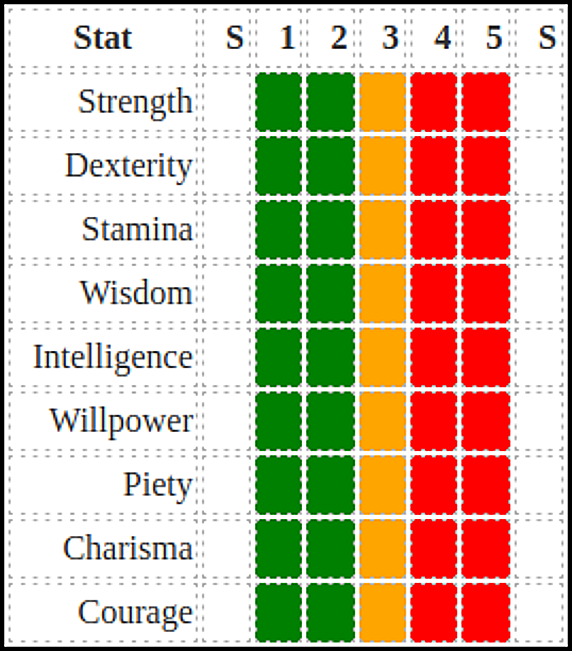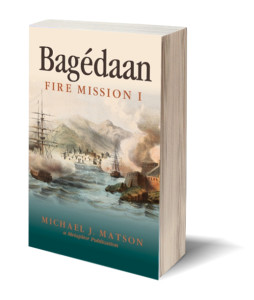
Our Generic RPG Stat System
We want to make the World of Menelon easily accessible to as many RPG writers, gamers, and gaming systems as possible. Therefore, we've developed our generic RPG stat system. But there are many gaming systems, each with their own stats—or no stats at all—and their own way of dealing with those statistics. Therefore, we've decided it best to follow the "KISS" principle". In other words, Keep It Simple, Stupid.
Our Generic RPG Stats
| Stat | S | 1 | 2 | 3 | 4 | 5 | S |
|---|---|---|---|---|---|---|---|
| Strength | |||||||
| Dexterity | |||||||
| Stamina | |||||||
| Wisdom | |||||||
| Intelligence | |||||||
| Willpower | |||||||
| Piety | |||||||
| Charisma | |||||||
| Courage |
As you can see from the table left, stats only run from 1 to 5, making 3 the statistical middle, or average. For clarity, average, in our generic RPG stat system, means human average. So that column is colored orange.
Though they're not separated in the tables, stats are broken down into three categories to further facilitate translation to your gaming system.
Physical
The first three stats are Strength, Dexterity, and Stamina.
Strength is, in generic terms, how much the person can physically lift, push, or manipulate However, how you interpret that will be specific to the context of the generic table you're looking at and your game. For example, the average human male can lift around 56 kilos (125 pounds) without training; the average female can lift around 27 kilos (60 pounds) without training. So if the chart is describing a female, and the strength is 3 (average), then she'll be able to lift around 27 kilos. If the chart is showing an average male, he'll be able to lift 56 kilos. But if you're looking at the table for the Common Orc, the text says there's no difference between the sexes in physical strength. So such distinctions aren't necessary.
Dexterity, describes reaction time, although it may also be also be used to describe how fast the creature is. However, it has the ability to run a 100 yard dash in record time, for example—the stat Speed, in some systems—it will be expressed in the text.
Stamina is pretty much self explanatory. In some game systems is called endurance, which gets to the same place. Long distance runners will have great Stamina. Desk jockeys will not.
Mental
The second category, in our generic RPG stat system, covers the logical processes.
- Wisdom: A measure of good old fashioned common sense and good is their judgment—regardless of the level of education. A highly educated individual with no practical experience would have a lower wisdom score than an illiterate, but highly skilled blacksmith.
- Intelligence: This should be understood not as a measure of formal education, but rather a measure of the creature's analytical and problem solving skills. Again, it's entirely possible for a highly educated professor to have a lower intelligence score than a blacksmith. Even though the latter may have little to no formal education, they must analyze and solve problems that have real world consequences every day. The professor's theories may never touch the real world.
- Willpower: How easy are they to manipulate? How much willpower can they bring to the task at hand. Or, if captive, how much mental abuse can they withstand?
Spiritual/psychological
Of the last three stats, Piety is probably the most obscure. If you're using the Fantasy World of Menelon for your game, and the religious/supernatural system built into it, its interpretation will be fairly straightforward. How well does the character/creature follow the theological and moral codes of their religion? However, your game, or game world, may be very different. The last two, Charisma and Courage, need little explanation.
The Specials
Obviously, even with our generic stat system, not every creature can be realistically compared to human norms. Trying to express the strength of an elephant in human terms, for example, would be ridiculous. Likewise for many fantasy creatures. Therefore, in these cases, we toss out the "compared to human norms" model and compare the creature to other creatures of the same species.
| Stat | S | 1 | 2 | 3 | 4 | 5 | S |
|---|---|---|---|---|---|---|---|
| Strength | ♦ | ♦ | |||||
| Strength | ♦ | ♦ |
The table on the left is an example of such a creature, expressed using our generic rpg stat system Notice that the S columns are dark red with diamonds in them. Also observe who the 1-5 scale alternates yellow and black (dark gray, really) like a warning tape, with one square filled either in red, green, or orange, just as we did in the full state table above. The black (dark gray) square indicates the creature's ability compared to others of its kind.
- In the first example, the 4 square is filled in red. This creature has above average strength compared to the average of 2 for its species.
- The second example, the 2 square is green, indicating the creature has below average strength compared a species wide average of 4.
But what about those creatures whose abilities are measurable against human norms? They just go beyond them at one end of the scale or the other. Or, what about a really sick human whose bed-ridden, or suffering from psychosis?
| Stat | S | 1 | 2 | 3 | 4 | 5 | S |
|---|---|---|---|---|---|---|---|
| Strength | > |
That's the real purpose of the S columns at either end of the scale. In the first example, the 4 and 5 squares are lit up in red and the S column has a greater than sign in it. These creatures strength are at minimum greater than a human's by 20% to 40% and can go way above that. How much beyond should be explained in the text. (If its not, contact us because we missed something.)
| Stat | S | 1 | 2 | 3 | 4 | 5 | S |
|---|---|---|---|---|---|---|---|
| Strength | < |
The next example could be a table for a population suffering from a degenerative disease. Their maximum strength is the human average, but can fall way below even human norms. Again, how much below should be explained in the text.
Specific Characters vs. General Classes
The examples given so far have dealt with general classes of characters/creatures. In some cases, like the last two example above, more than one square on the 1-5 scale is colored.
The fact is, in most charts this is not true. Only one square will be colored, showing the average for the species as compared to the human average.
Only in special cases will multiple blocks be colored in. So when looking at a chart it's important to remember whether you're looking at a specific character, or a class of creatures. Because the charts will look exactly the same.
We'd love to hear from you. Tell us what you think about our generic RPG stat system. Have you converted some characters or creatures? Tell us how it went in the comments. Got a recommendation? We'd love to hear it.
